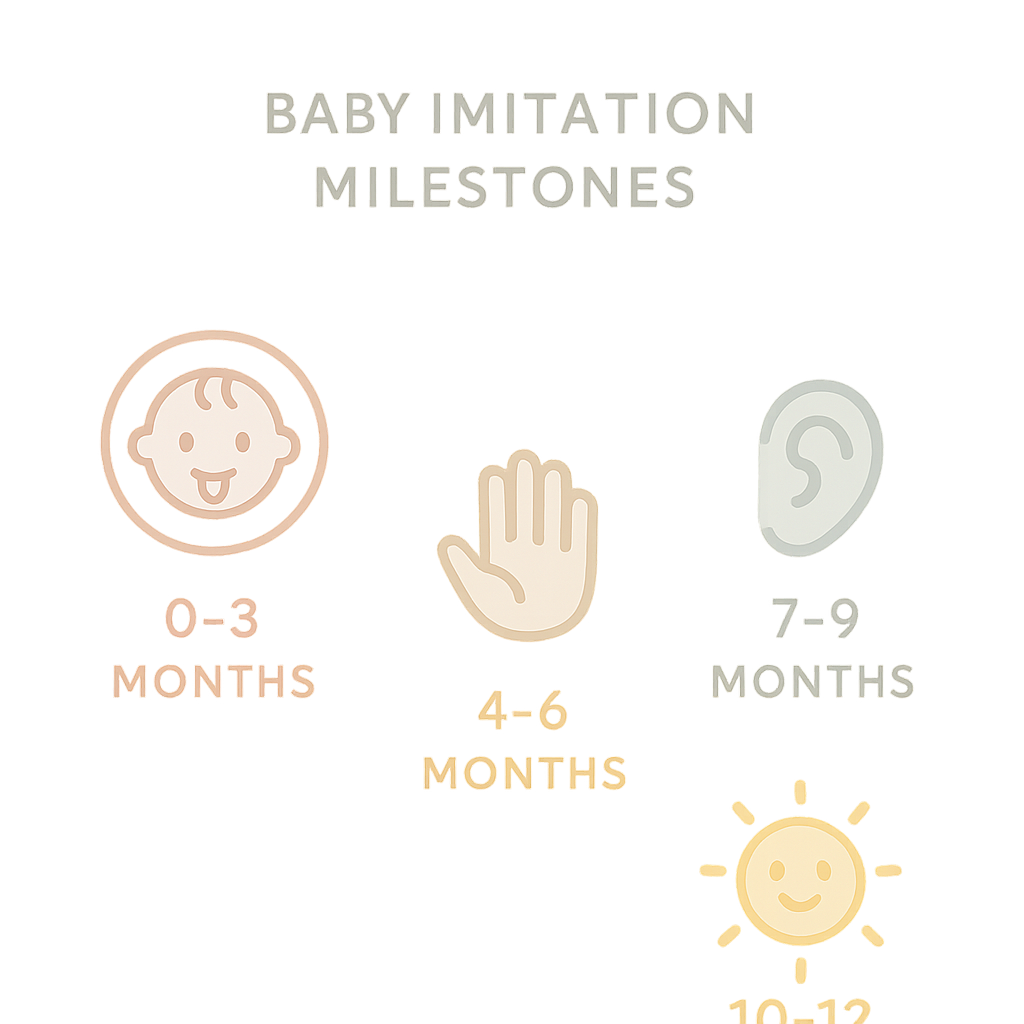Your baby sticks out her tongue, you copy—and a lifelong learning loop ignites. That tiny moment of “monkey see, monkey do” switches on mirror neurons, showers the brain in feel-good chemicals, and forges pathways your child will use for language, problem-solving, and empathy. Your baby sticks out her tongue, you copy—and a lifelong learning loop ignites. That tiny moment of “monkey see, monkey do” switches on mirror neurons, showers the brain in feel-good chemicals, and forges pathways your child will use for language, problem-solving, and empathy. Explore how imitation boosts language skills.
- What exactly is imitation play, and why are babies wired to copy you?
- How do imitation games light up mirror neurons and build brain architecture?
- Which core skills—cognitive, language, and social—get turbo-charged by copycat play?
- When do babies start imitating, and what milestones guide game choice?
- What are the best age-appropriate imitation games I can play today?
- How can everyday routines become brain-building copycat moments?
- What if my baby isn’t imitating yet—should I worry?
- How can copycat play be adapted for diverse needs and cultures?
- Your top questions, answered
- Final thoughts
What exactly is imitation play, and why are babies wired to copy you?
Imitation play is any back-and-forth game where a baby and caregiver mirror each other’s sounds, faces, or actions.
From reflexive tongue wiggles at a few weeks old to deliberate clapping by nine months, copycat play is the brain’s favorite shortcut to learning. A 2020 Lund University study found 6-month-olds smiled and made eye contact three times more when adults mirrored them—proof that “serve-and-return” interactions feel rewarding and keep babies engaged. Read the Lund study. Each volley of imitation contributes to forming over a million new neural connections per second, fertilizing brain growth faster than any flash-card app ever could. Understand brain development. For more easy brain builders, explore Boost Your Baby’s Brain Power.

How do imitation games light up mirror neurons and build brain architecture?
Mirror neurons fire both when your baby does something and when they watch you do it, creating a double dose of learning.
Functional near-infrared spectroscopy (fNIRS) scans show Broca’s area—home base for speech—glows brighter when infants copy tongue protrusions than when they simply watch. Repetition during the first two years strengthens useful synapses and prunes weaker ones, wiring efficient circuits for movement, speech, and self-control. See why repetition matters. Pair copycat play with tummy time from our Tummy Time Benefits guide to link strong bodies with strong brains.
Which core skills—cognitive, language, and social—get turbo-charged by copycat play?
Copycat play boosts thinking skills, vocabulary size, and emotional bonding all at once.
- Cognitive: Deferred-imitation studies show 12-month-olds remember a new action 30 seconds longer after copycat practice, a building block for future executive function.
- Language: Babies who experience rich “conversational turns” by 18 months boast 20–30 percent larger vocabularies at age two (PNAS 2020). Singing and gesture games from Nursery Rhymes: How Singing Boosts Your Baby’s Brain amplify the effect.
- Social-emotional: Mutual mimicry triggers oxytocin release, deepening attachment and planting the seeds of empathy.
When do babies start imitating, and what milestones guide game choice?
Most babies begin intentional imitation between three and four months, then master new layers every few months.
| Age (months) | Typical Imitation Milestone |
|---|---|
| 0–3 | Copies facial expressions (open mouth, tongue out) |
| 4–6 | Echoes coos and vowel sounds |
| 7–9 | Claps, waves, bangs objects in sync with you |
| 10–12 | Imitates simple words, gestures, and tool use |
If your baby isn’t gesturing by 10 months or babbling by 7 months, flag it for your pediatrician Check language milestones.

What are the best age-appropriate imitation games I can play today?
Choose games that match your baby’s current milestone and add a twist as skills grow.
0–6 months
- Face Dance: Match baby’s smiles, blinks, and yawns.
- Echo Coo: Repeat every coo or gurgle like a duet. Pair with high-contrast cards from High-Contrast Books.
6–9 months
- Clap-Back Patty-Cake: Let baby set the rhythm, then add a new clap pattern.
- Peek-a-Boo 2.0: Hide a toy under a cloth to teach object permanence—see our Peek-a-Boo Games.
9–12 months
- Do This, Do That: Touch nose, pat head, or stomp feet and invite baby to copy.
- Beanbag Copycat: Toss a soft beanbag into a basket, then hand it to baby. Connect this to block play ideas in Blocks and Cups.
All ages
- Texture Twins: Rub a crinkly scarf, let baby imitate, and describe “scratchy,” “soft,” or “bumpy” to build sensory language. Find more in Sensory Play Ideas.
How can everyday routines become brain-building copycat moments?
Turn ordinary chores into miniature neuroscience labs.
Mealtime: Baby bangs a spoon; you bang yours and label “bang-bang spoon.”
Diaper change: Sing “Itsy Bitsy Spider,” guiding tiny fingers through the motions.
Bath: Copy water splashes, then narrate cause-and-effect—see more in Cause-and-Effect Play.
Bedtime: Make shadow puppets on the wall and encourage baby to lift hands, fostering calm proprioception.
What if my baby isn’t imitating yet—should I worry?
A slow start can be normal, but certain gaps warrant a check-in.
Watch for no babble by 7 months, no gestures by 10 months, or no word attempts by 15 months. Support your baby by exaggerating mouth shapes, using mirrors, and keeping background screens off—Play vs. TV explains why. Persistent delays can signal speech or neurodevelopmental concerns such as autism; early speech-language therapy makes a big difference.
How can copycat play be adapted for diverse needs and cultures?
Flexible copycat games meet every family’s language, ability, and resource mix.
Neuro-divergent infants benefit from simple, predictable one-step actions paired with clear visual support. In multilingual homes, model the same gesture while naming it in each language—boosts code-switching and cultural pride Support bilingual development. No fancy toys? Use pots as drums, scarves for peek-a-boo, or traditional clapping rhymes passed down through generations. As Zero to Three notes, culturally responsive serve-and-return play strengthens both identity and cognition.
Your top questions, answered
-
Does copying my baby actually teach them, or just entertain?
It teaches. Each mirrored action strengthens neural pathways for attention, memory, and language while flooding your baby with social reward chemicals that make learning stick. -
How long should an imitation game last?
Follow your baby’s cues. Most infants stay engaged for 2–5 minutes; end sooner if they look away or fuss, and try again later. -
Can older siblings lead imitation play?
Yes—safely supervised sibling copycat sessions boost both children’s social skills. The baby learns from a closer peer model, and the older child practices empathy and leadership. -
Are screen-based imitation apps helpful?
Live humans beat screens. Apps may show movements, but they lack eye contact, timing, and emotional feedback that drive brain growth. If you use an app, co-view evidence-backed options like “Peekaboo Barn” ($1.99). Say the animal name together, then close the device and find the toy version.
Final thoughts
Every smile you mirror, every silly sound you echo, and every gesture you share is a micro-investment in your baby’s future curiosity, empathy, and communication. Keep the copycat rhythm flowing, explore more ideas in our 15-Activity Guide, and watch your little learner’s world light up.